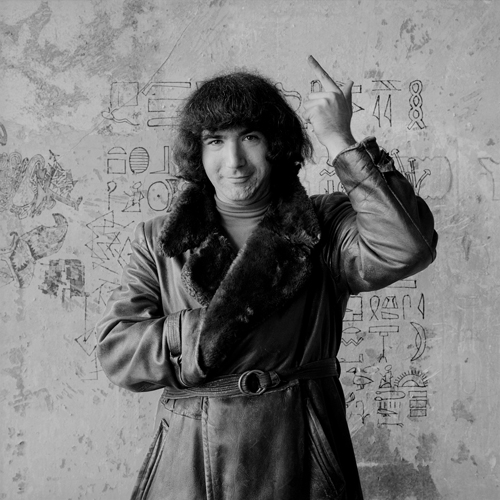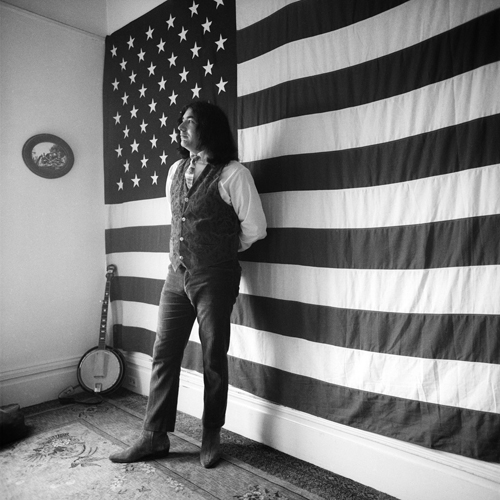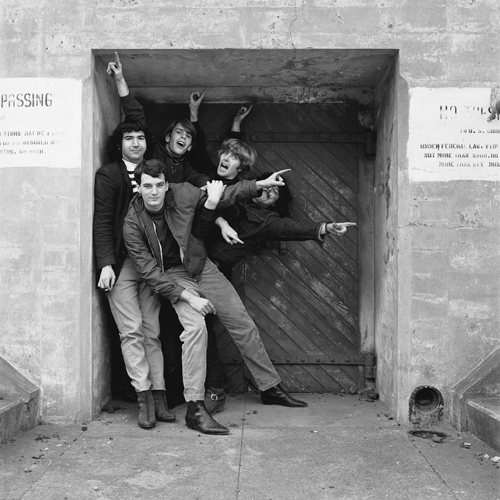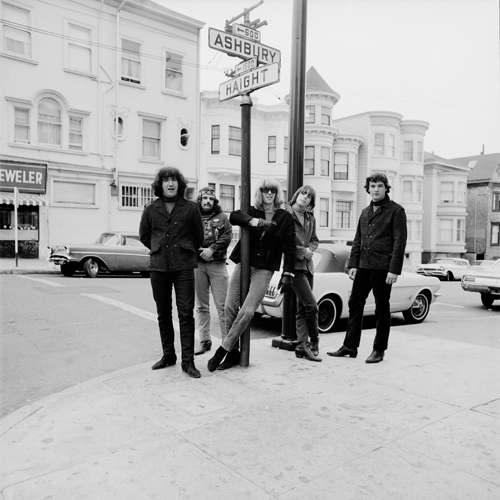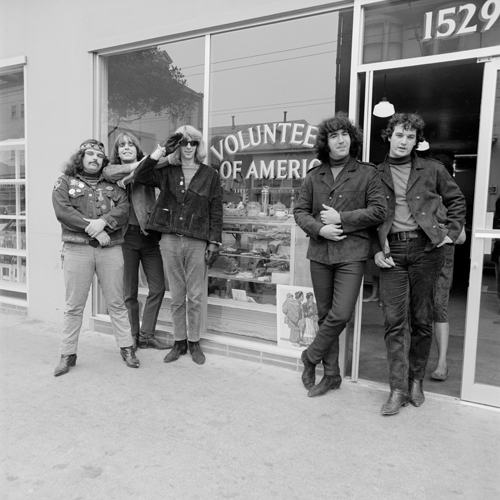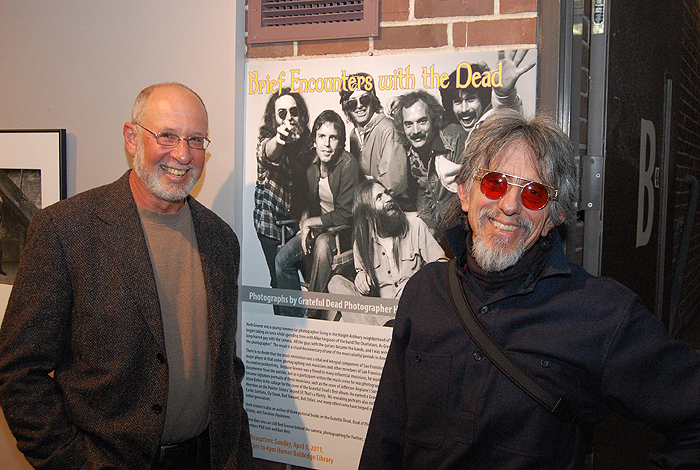
If every picture tells a story, there are at least several tales behind the exhibition Brief Encounters with the Dead – a collection of portraits of the Grateful Dead now on display in the Stevens Gallery at the Homer Babbidge Library through June 10 – starting with how the exhibit arrived in Storrs.
Two years ago Brinley Franklin, vice provost of UConn Libraries, accompanied his wife, Raynna Bowlby, an academic library consultant, when she traveled on a work assignment to the University of California at Santa Cruz. At the time, that library was just beginning to organize a major acquisition – The Grateful Dead Archive, containing documents and artifacts, including stage props, tour memorabilia, photos, and T-shirts, as well as items from the band’s loyal fans, The Deadheads – from the 30 years of the band’s existence.
“Raynna told the library director I had a lot of Dead music,” says Franklin, who has listened to Jerry Garcia and company for many years. “They had just been given the material, so they laid out some things from the collection for me to look at. One of the things they put out was the photo ‘Dylan and The Dead’ from 1987. I’m probably more of a Dylan fan than a Dead fan. I just loved the photo. I decided to track down the photographer, thinking he probably lived in California. It turned out he lived in Maynard, Mass., an hour and a half away from UConn.”
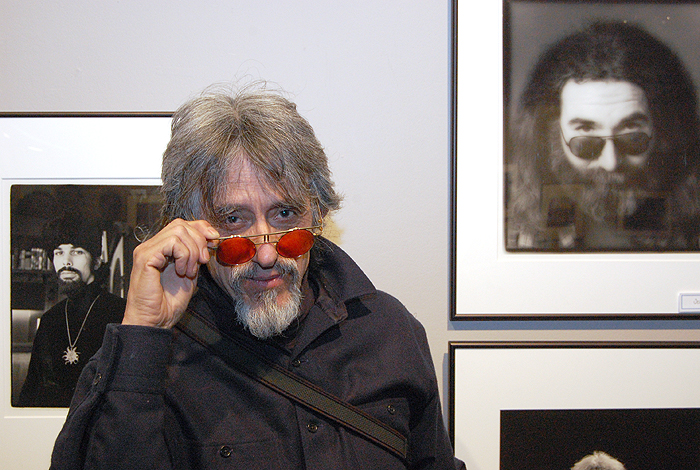
The photographer was Herb Greene, a former staff photographer at Joseph Magnin & Co., the well-known San Francisco department store, in the 1960s. Greene began taking portraits of Bay area bands in the mid-1960s during the early days of the region’s psychedelic bands, including The Warlocks, the precursor to the Grateful Dead. Greene met lead guitarist Jerry Garcia one day when he heard bluegrass music coming from a local bar and spoke to the musicians after they finished playing. It was the start of what was to become a decades-long friendship.
The Grateful Dead fused a variety of musical styles over its time as a band, but is primarily known for incorporating improvisation into its concert performances, pioneering a performance style later known as jam band. The shows were attended by legions of Deadheads, who were encouraged to record the shows, a precursor to the evolution of the music industry’s free Internet downloads. Although they released more than 130 albums during and after the band’s existence, the Dead’s greatest commercial success did not occur until 1987 with the single “Touch of Grey,” the group’s only Top 10 hit on the pop charts.
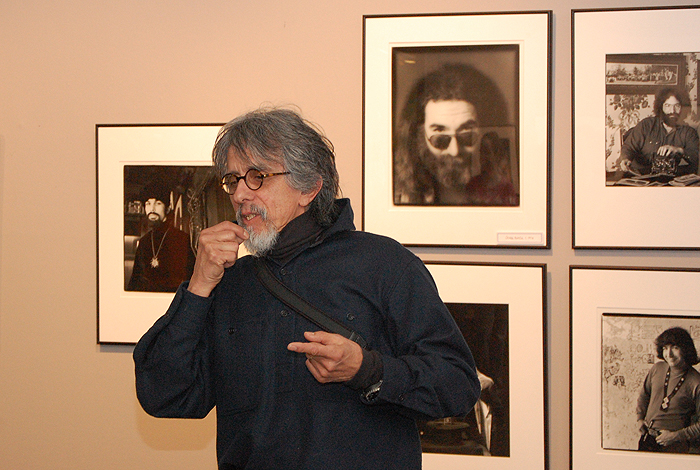
Greene, who came to campus for the opening reception for his photo exhibition says he has been surprised by the increased interest in his photographs in recent years. As a body of work, they number only about 1,000 images, compared with the much larger volume of work produced by rock photographers such as Jim Marshall, whose images of Jimi Hendrix, Johnny Cash, and performers at the 1969 Woodstock Music and Arts Festival are well known.
“I really don’t consider myself a photographer,” Greene says. “I consider myself a portrait photographer, a portraitist if you must. Seeing me with a camera on is really unusual. I never took snapshots. I had opportunities, but I can’t intrude. It’s intrusive. Some people can do it. I can’t. I can’t take stage pictures. I’m no good at it.”
Still, Greene says he is realizing that his connection to the musicians he worked with for so long is important to fans, and he has begun using social media and updating his online presence, including launching a new website.
“All of a sudden, I realize this is important,” he says. “I’ve thought the work was important, but I never thought of myself as important. All of a sudden I am important to other people. That’s why I’m interested in social media. What’s happened now is that there’s not that many of us left. The work has been recognized for what it is, thankfully. I might as well take credit for it.”
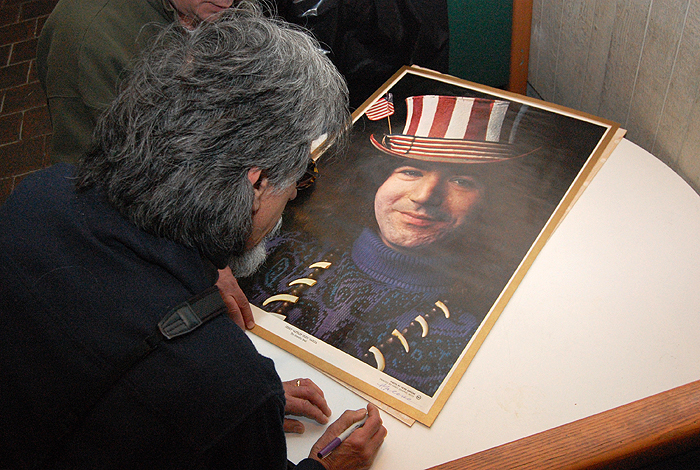
In addition to his photos of the Dead, Greene took portraits of Big Brother and the Holding Company and its lead singer, Janis Joplin; Carlos Santana; Blue Cheer; Steve Miller; and Jefferson Airplane, among others. His photos have been published in magazines such as Rolling Stone and Newsweek, and his work is on permanent display at the Rock and Roll Hall of Fame and Museum in Cleveland.
As guests assembled in the Stevens Gallery for the exhibit’s opening reception, several approached Greene asking him to sign books, posters, and album covers with his photographs. Some of the notable images he signed included a poster of Garcia, sans beard, wearing an American flag top hat known as “Captain Trips;” Garcia, a book of stories and interviews published by Rolling Stone magazine; and the vinyl album “Surrealistic Pillow,” the first Jefferson Airplane recording, which has Greene’s portrait of the band on the cover.
While answering questions at the reception, Greene recalled that soon after Garcia died in 1995, he was talking with the musician’s daughters at their office in California when they told him a story about Garcia seeing some of his photos hanging on the office walls.
“I had never shown Jerry any of my work, ever. He wasn’t interested. You took pictures and gave them to the people in charge of PR,” he said. “I was sitting there and they said, ‘Our Dad told us: These pictures on the wall. I’m really not that bad looking a guy at all.’”
Other photographs, mostly black and white prints, included in the Babbidge Library exhibit:
- “Haight-Ashbury,” one of the earliest portraits of the Grateful Dead, standing at the corner of Haight and Ashbury streets in San Francisco (1967).
- “Perfect Garcia,” Garcia sitting in a chair holding a switchblade in his right hand (1969).
- “Jerry and Mountain Girl,” Garcia with Carolyn “Mountain Girl” Adams, a former member of the Merry Pranksters who became his wife (1967).
- “Dylan and The Dead,” Bob Dylan sitting amid the band members, with Garcia and Weir holding electric guitars (1987).
- “Garcia on Broadway,” a portrait, with Garcia wearing a cape and guitar coming out of a top hat for the Playbill cover distributed during the Jerry Garcia Band performances at the Lunt-Fontanne Theatre in New York City (1987).
